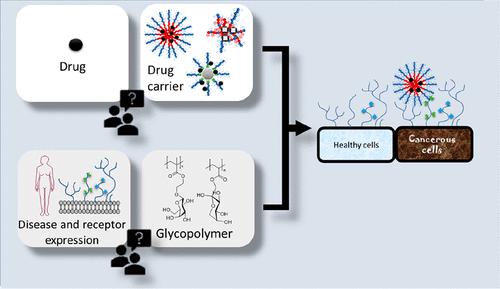当前位置:
X-MOL 学术
›
Macromolecules
›
论文详情
Our official English website, www.x-mol.net, welcomes your
feedback! (Note: you will need to create a separate account there.)
Glycopolymers for Drug Delivery: Opportunities and Challenges
Macromolecules ( IF 5.1 ) Pub Date : 2022-06-08 , DOI: 10.1021/acs.macromol.2c00557 Martina H. Stenzel 1
Macromolecules ( IF 5.1 ) Pub Date : 2022-06-08 , DOI: 10.1021/acs.macromol.2c00557 Martina H. Stenzel 1
Affiliation

|
Glycopolymers are synthetic polymers with pendant sugars, which hold promise for a range of biomedical applications ranging from tissue engineering to sensing. The known specific interaction of glycopolymers with lectins has inspired researchers to use these polymers to deliver drugs to cells that overexpress lectin receptors. As a result, many glycopolymers─based on mannose, galactose, fructose, or other saccharides–have been used for the targeted delivery of drugs, ranging from traditional anticancer drugs to nucleic acid-derived therapeutics. For drug delivery purposes, glycopolymers are typically processed into nanoparticles that form a matrix to entrap the drug safely, such as micelles, polyplexes, polyion complex micelles, or other nanosized carriers. In vitro and in vivo studies have shown that drugs can indeed be delivered selectively to specific cells by leveraging the selective recognition of surface bound lectins. The key to the interaction between glycopolymers and lectins is the presence of strong intermolecular forces such as hydrogen bonding. The formation of strong hydrogen bonds can, however, also be one of the drawbacks of these materials. Glycopolymers tend to self-aggregate, they interact with drugs in unexpected ways, or they bind proteins in a nonspecific manner. Despite these challenges, nanoparticles based on glycopolymers might offer possibilities that cannot be replicated by other water-soluble polymers. They have already shown that they can effectively deliver drugs in vivo, though more preclinical studies are necessary to enable their broader clinical uptake. Further focus could be directed at an improved understanding of the interface between glycopolymers and the biological surrounding as a key to improve the targeting ability of these nanoparticles in vivo. In this Perspective, I will discuss the aspects to consider when preparing drug delivery carrier using glycopolymers. This will include the interaction of the glyconanoparticles with the drug and the resulting property changes, the types of glycopolymers suitable for drug delivery, the effect of the nanoparticle structure on the affinity to cell surface bound lectins or GLUT transporters and the promising in vivo results that show selective delivery.
中文翻译:

用于药物输送的糖聚合物:机遇与挑战
糖聚合物是具有侧链糖的合成聚合物,有望用于从组织工程到传感等一系列生物医学应用。糖聚合物与凝集素的已知特异性相互作用激发了研究人员使用这些聚合物将药物输送到过度表达凝集素受体的细胞。因此,许多基于甘露糖、半乳糖、果糖或其他糖类的糖聚合物已被用于靶向递送药物,从传统的抗癌药物到核酸衍生的治疗药物。出于药物递送目的,糖聚合物通常被加工成纳米颗粒,形成基质以安全地包裹药物,例如胶束、复合物、聚离子复合胶束或其他纳米尺寸的载体。体外和体内研究表明,通过利用表面结合凝集素的选择性识别,药物确实可以选择性地输送到特定细胞。糖聚合物和凝集素之间相互作用的关键是存在强分子间力,例如氢键。然而,强氢键的形成也可能是这些材料的缺点之一。糖聚合物倾向于自我聚集,它们以意想不到的方式与药物相互作用,或者它们以非特异性方式结合蛋白质。尽管存在这些挑战,但基于糖聚合物的纳米颗粒可能提供其他水溶性聚合物无法复制的可能性。他们已经证明他们可以在体内有效地递送药物,尽管需要更多的临床前研究才能使其更广泛的临床应用。进一步的重点可以集中在更好地理解糖聚合物和生物环境之间的界面,这是提高这些纳米颗粒在体内的靶向能力的关键。在本文中,我将讨论使用糖聚合物制备药物递送载体时要考虑的方面。这将包括糖纳米颗粒与药物的相互作用以及由此产生的性质变化、适用于药物递送的糖聚合物类型、纳米颗粒结构对与细胞表面结合的凝集素或 GLUT 转运蛋白的亲和力的影响以及有希望的体内结果显示选择性交付。
更新日期:2022-06-08
中文翻译:

用于药物输送的糖聚合物:机遇与挑战
糖聚合物是具有侧链糖的合成聚合物,有望用于从组织工程到传感等一系列生物医学应用。糖聚合物与凝集素的已知特异性相互作用激发了研究人员使用这些聚合物将药物输送到过度表达凝集素受体的细胞。因此,许多基于甘露糖、半乳糖、果糖或其他糖类的糖聚合物已被用于靶向递送药物,从传统的抗癌药物到核酸衍生的治疗药物。出于药物递送目的,糖聚合物通常被加工成纳米颗粒,形成基质以安全地包裹药物,例如胶束、复合物、聚离子复合胶束或其他纳米尺寸的载体。体外和体内研究表明,通过利用表面结合凝集素的选择性识别,药物确实可以选择性地输送到特定细胞。糖聚合物和凝集素之间相互作用的关键是存在强分子间力,例如氢键。然而,强氢键的形成也可能是这些材料的缺点之一。糖聚合物倾向于自我聚集,它们以意想不到的方式与药物相互作用,或者它们以非特异性方式结合蛋白质。尽管存在这些挑战,但基于糖聚合物的纳米颗粒可能提供其他水溶性聚合物无法复制的可能性。他们已经证明他们可以在体内有效地递送药物,尽管需要更多的临床前研究才能使其更广泛的临床应用。进一步的重点可以集中在更好地理解糖聚合物和生物环境之间的界面,这是提高这些纳米颗粒在体内的靶向能力的关键。在本文中,我将讨论使用糖聚合物制备药物递送载体时要考虑的方面。这将包括糖纳米颗粒与药物的相互作用以及由此产生的性质变化、适用于药物递送的糖聚合物类型、纳米颗粒结构对与细胞表面结合的凝集素或 GLUT 转运蛋白的亲和力的影响以及有希望的体内结果显示选择性交付。











































 京公网安备 11010802027423号
京公网安备 11010802027423号